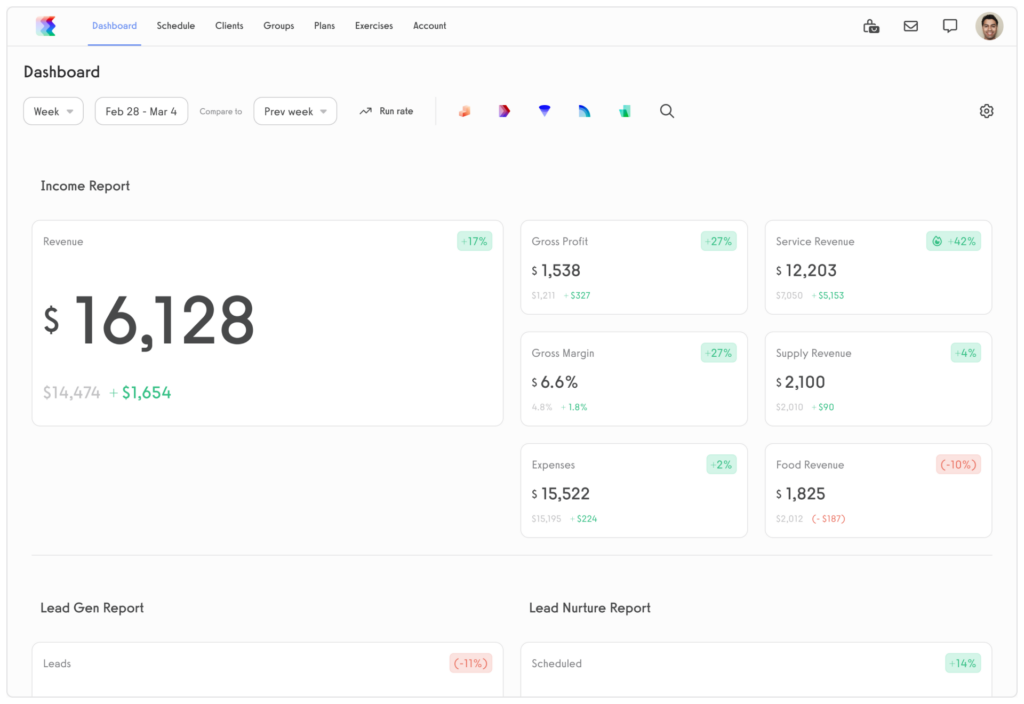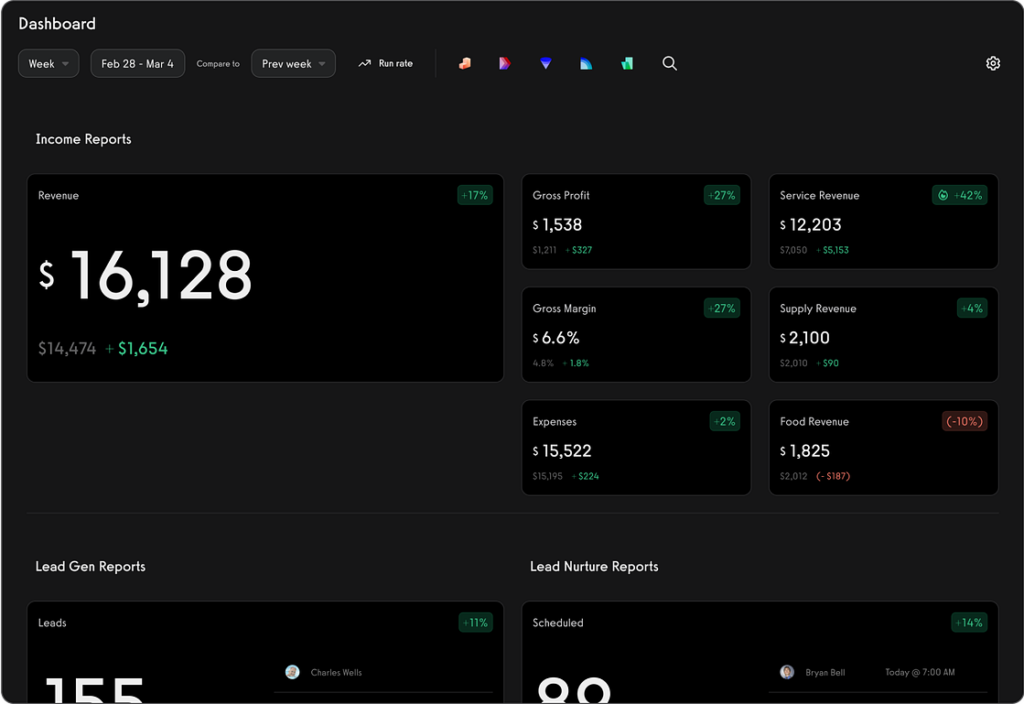Gym Sales Forecasting Guide (+ FREE Template)
Use this gym sales forecasting guide to learn how to create a gym sales forecast, why to create a sales forecast for a gym, and even get a free gym sales forecast example template that you can use. In today’s ever-changing fitness industry, it is crucial for gyms to effectively forecast their sales in order to stay competitive and maximize gym profitability.

Sales forecasting provides valuable insights into future gym revenue streams, allowing gym owners and managers to make informed decisions and set realistic goals. This comprehensive gym sales forecast guide aims to shed light on the importance of sales forecasting for gyms, the benefits it brings, and the key factors to consider when forecasting gym sales.

Discover the ultimate Gym Sales Forecasting Guide to boost your fitness business. And then be sure and see how the best gym software system can help your gym sales grow and exceed your forecast by supporting you as you create multiple gym revenue streams and offer online and in-person gym revenue options.

Gym Sales Forecast Example Template
When you’re starting or running a gym, a sales forecast is a vital part of your gym business plan and gym budget. It helps you predict future revenue and make decisions about expenses and growth. Below is a simple example of a gym sales forecast. It outlines 12 month expected gym sales from memberships, personal training, and other sources of income over a period of one year. Remember that actual numbers will vary based on a variety of factors including location, size of the gym, local market, etc.
12-Month Gym Sales Forecast Template
| Revenue Source | Jan | Feb | Mar | Apr | May | Jun | Jul | Aug | Sep | Oct | Nov | Dec | Total |
|---|---|---|---|---|---|---|---|---|---|---|---|---|---|
| Gym Memberships | $20,000 | $20,000 | $22,000 | $22,000 | $24,000 | $24,000 | $26,000 | $26,000 | $28,000 | $28,000 | $30,000 | $30,000 | $298,000 |
| Personal Training | $5,000 | $5,500 | $6,000 | $6,500 | $7,000 | $7,500 | $8,000 | $8,500 | $9,000 | $9,500 | $10,000 | $10,500 | $93,500 |
| Group Classes | $3,000 | $3,300 | $3,600 | $3,900 | $4,200 | $4,500 | $4,800 | $5,100 | $5,400 | $5,700 | $6,000 | $6,300 | $56,700 |
| Other Sales (Merchandise, etc.) | $1,000 | $1,100 | $1,200 | $1,300 | $1,400 | $1,500 | $1,600 | $1,700 | $1,800 | $1,900 | $2,000 | $2,100 | $19,500 |
| Total Sales | $29,000 | $29,900 | $32,800 | $33,700 | $36,600 | $37,500 | $40,400 | $41,300 | $44,200 | $45,100 | $48,000 | $48,900 | $468,200 |
This is a simplified gym sales forecast for illustrative purposes. Your actual sales forecast will be more detailed and include variables such as the expected growth rate, the price of different memberships and services, costs, and so on. Regularly updating your sales forecast as you get real sales data will help you better manage your business and adjust your strategies as needed.
Read More:
- How to Create a Gym Business Plan
- How to Create a Gym Budget
- How to Create Multiple Gym Revenue Streams
- How to Increase Gym Revenue and Profit
How to Create a Gym Sales Forecast
Creating a sales forecast for your gym is crucial for your strategic planning and overall financial management. It provides you with a prediction of your future sales revenue and gives you insights into how your gym business might perform. It’s an ongoing process and becomes more accurate over time as you start to gather more historical data. Here’s a step-by-step guide to get you started.
Step 1: Understand What a Sales Forecast Is
Sales forecasting is an estimation of future sales over a specific period of time. This data is based on historical sales data, market analysis, and sales trends.
Step 2: Identify Your Revenue Streams
Start by identifying different revenue streams for your gym. These could include gym memberships, personal training, group classes, merchandise sales, rental income, etc.
Step 3: Determine the Units You Will Sell
Estimate the number of units you expect to sell from each revenue stream each month. For instance, how many gym memberships, personal training sessions, or group classes do you expect to sell?
Step 4: Set the Price for Each Unit
Next, establish the price for each unit sold. This could be the cost of a gym membership, the price of a personal training session, the fee for a group class, etc.
Step 5: Calculate Sales for Each Revenue Stream
For each revenue stream, multiply the number of units by the price per unit. This gives you the total sales forecast for each revenue stream.
Step 6: Create a Monthly Sales Forecast
Combine the sales forecast for all revenue streams to get your total sales forecast for each month.
Step 7: Analyze and Adjust
Finally, it’s essential to remember that your sales forecast is a dynamic document. Regularly review and update your forecast as you gain more data about actual sales and as market conditions change. You’ll likely find that your forecasts become more accurate over time.
Remember, while the numbers are important, the real value in sales forecasting comes from understanding the assumptions that influence these numbers. Always question and evaluate these assumptions to ensure they’re as accurate as possible. The goal is to create a realistic picture of your gym’s future sales.
As you go through this process, software like Exercise.com can help you to manage your gym’s operations more efficiently and provide you with the data you need to create more accurate forecasts. By using a platform that combines membership management, scheduling, and billing, you can get a clearer picture of your revenue streams and better understand your gym’s financial health.

Ready to learn more?
How Exercise.com Can Help Forecast Gym Sales
Here’s just some of what you can do with the Exercise.com platform to help you have more certainty around future gym revenue streams, gym payment processing, recurring gym memberships, and online training and other gym ecommerce revenue.
View all of your gym business reports easily to analyze trends and patterns.

Manage multiple gym locations with ease and share data across locations and to the HQ based on robust permissions.

Dig into details on a per member or per product basis.

Analyze trainer and staff performance
Process payments easily with the best gym payment processing software solution.

Integrate with your calendar and scheduling.

All from your own custom branded gym apps.

Want to learn more?
Understanding the Importance of Sales Forecasting for Gyms
Sales forecasting plays a pivotal role in the success of any gym business. By accurately predicting future sales, gym owners can effectively plan their resources, adjust marketing strategies, and allocate budgets for various expenses. Without reliable sales forecasts, gyms may face unforeseen challenges such as overstaffing or inadequate inventory, which can negatively impact both finances and customer satisfaction.
Moreover, sales forecasting allows gyms to identify potential growth opportunities or areas that require improvement. By examining trends, patterns, and external factors, gym owners can strategically position their businesses for success, adapt to market changes, and exploit new market segments.
One key benefit of sales forecasting for gyms is the ability to optimize pricing strategies. By analyzing historical sales data and market trends, gym owners can determine the optimal price points for their services. This can help attract new customers, retain existing ones, and maximize revenue.
In addition, sales forecasting can also assist gyms in managing their inventory effectively. By accurately predicting future demand, gym owners can ensure that they have the right amount of equipment, supplies, and merchandise on hand. This helps prevent stockouts and ensures that customers have access to the resources they need, enhancing their overall experience at the gym.
The Benefits of Implementing Sales Forecasting in your Gym Business
Implementing sales forecasting in your gym business offers a myriad of benefits. Firstly, it provides a clear picture of your gym’s potential earnings, enabling you to set realistic goals and create a roadmap for growth. By having a well-defined target, you can align your marketing efforts, sales strategies, and operational tactics to achieve optimal results.
Secondly, sales forecasts facilitate effective resource management. By accurately estimating future demand, gym owners can ensure they have sufficient manpower, equipment, and supplies to meet customer needs without overspending or experiencing shortages.
Additionally, sales forecasting helps in identifying potential trends and market opportunities. By staying on top of industry developments and analyzing historical data, you can leverage market trends, adapt your offerings, and stay ahead of the competition. Whether it’s introducing new classes, targeting specific demographics, or investing in state-of-the-art equipment, sales forecasting empowers you to make data-driven decisions that maximize your gym’s potential.
Furthermore, sales forecasting can also assist in financial planning and budgeting. By accurately predicting future revenue and expenses, gym owners can create a comprehensive financial plan that ensures the business remains profitable and sustainable. This includes setting realistic pricing strategies, allocating resources effectively, and identifying areas for cost-saving measures.
Key Factors to Consider When Forecasting Gym Sales
When forecasting gym sales, several key factors must be taken into account. Firstly, understanding your gym’s target market is essential. Analyzing demographic data, such as age groups, income levels, and location, can provide valuable insights into customer preferences and purchasing power. This information lays the foundation for accurate sales projections.
Furthermore, historical sales data should be carefully analyzed. By examining past performance, seasonal trends, and year-to-year growth, you can identify patterns and forecast future sales more effectively. Consider factors such as peak seasons, new member acquisition rates, and member retention rates to develop a comprehensive sales forecast.
Additionally, external factors that could impact your gym’s sales should be factored in. Economic conditions, industry trends, and even weather can influence consumer behavior. By monitoring and adjusting your sales forecast based on these external factors, you can stay one step ahead of changes in the market and adapt accordingly.
Moreover, it is important to consider the competitive landscape when forecasting gym sales. Analyzing the market share of other gyms in the area, their pricing strategies, and the services they offer can help you understand the level of competition you are facing. This information can guide your sales forecast by allowing you to anticipate potential challenges and adjust your strategies accordingly. Work with your key staff and train your gym sales manager to help you dial in your gym sales forecasting workflow.
Gathering and Analyzing Data for Accurate Sales Forecasts in the Fitness Industry
Accurate sales forecasting heavily relies on gathering and analyzing data specific to the fitness industry. One important aspect is the collection of customer data. By obtaining demographic information, attendance patterns, and membership preferences, you can develop a solid understanding of your gym’s customer base, enabling you to make data-driven forecasts.
Additionally, it is crucial to keep track of various sales channels. Whether it’s memberships, personal training sessions, or merchandise sales, each sales channel contributes differently to overall revenue. By analyzing the performance of each channel and establishing correlations, you can refine your sales forecasts and identify areas of potential growth.
Utilizing technology and software tools designed for sales forecasting can greatly streamline the data collection and analysis process. From member management software to data analytics platforms, these tools allow you to generate comprehensive reports, visualize trends, and make accurate projections with ease.
Furthermore, it is essential to consider external factors that may impact sales in the fitness industry. These factors can include seasonal trends, economic conditions, and industry-specific events. By incorporating these external variables into your data analysis, you can enhance the accuracy of your sales forecasts and make informed decisions to optimize your business strategies.
Utilizing Historical Sales Data to Predict Future Gym Sales
One powerful tool at your disposal for accurate sales forecasting is your gym’s historical sales data. By leveraging past performance, you can identify recurring trends, seasonal patterns, and growth opportunities. Analyzing historical data allows you to make informed predictions about future gym sales and plan accordingly.
Start by examining sales data from the previous year, breaking it down into smaller timeframes such as months, weeks, or even days. Look for patterns or correlations with external factors such as holidays or the start of the New Year. This analysis can help you identify periods of increased demand and plan promotional campaigns effectively.
Furthermore, consider the historical growth rate of your gym. By calculating the average growth over a specific period, you can project the likely future growth and adjust your sales forecast accordingly. However, it’s important to validate these projections against current market conditions and external factors to ensure reliability.
Another important aspect to consider when utilizing historical sales data is customer behavior. By analyzing past sales data, you can gain insights into customer preferences, purchasing patterns, and membership trends. This information can help you tailor your marketing and gym membership sales strategies and offerings to better meet the needs and preferences of your target audience.
In addition to examining historical sales data, it can also be beneficial to incorporate other relevant data sources into your analysis. For example, you can gather data on local economic indicators, population demographics, and industry trends to further refine your sales forecasting models. By combining multiple data sources, you can create a more comprehensive and accurate prediction of future gym sales.
How do you forecast gym sales?
Forecasting gym sales involves analyzing historical data, trends in your membership numbers, and your local market conditions. Factors like seasonal variations, gym membership churn rate, and the impact of marketing campaigns should be considered. Using Exercise.com can significantly help in this process, as it provides extensive analytics and reporting features to make sense of your data and forecast sales more accurately.
How do you forecast a gym membership?
To forecast gym memberships, you would look at your historical data, seasonality factors (for example, many people sign up for gyms in January as part of New Year’s resolutions), and any upcoming marketing campaigns or events. The forecasting should take into account factors such as the average duration of memberships, churn rate, and acquisition rate of new members. With Exercise.com, you can keep track of these metrics seamlessly, facilitating more accurate forecasting.
What is the best formula to forecast gym sales?
There isn’t a single “best” formula to forecast gym sales as it depends on multiple factors. However, a common method is to multiply the number of expected members (based on historical trends and market conditions) by the average revenue per member. Exercise.com’s analytics can provide insight into these factors, allowing for a more informed prediction.
What are typical gym sales forecasting methods?
Typical gym sales forecasting methods involve analyzing historical sales data, considering the impact of seasonal trends, assessing the effectiveness of past marketing campaigns, and monitoring local market conditions. Using a tool like Exercise.com can simplify this process by providing detailed reporting and analytics features to aid in accurate forecasting.
How do I forecast gym sales in Excel?
Forecasting gym sales in Excel would involve creating a sales forecast template that includes your past sales data, future sales projections based on trends and market analysis, and any other factors that could affect sales such as seasonal trends or upcoming marketing initiatives. With Exercise.com, you can export reports that can then be used in Excel for further analysis and forecasting.
How do you forecast gym sales uplift?
To forecast gym sales uplift, you need to analyze the impact of various factors that could increase sales. This could include the introduction of new services or programs, effective marketing campaigns, or improvements in customer service. Exercise.com can help track the effect of these changes on membership numbers and revenue, facilitating a more accurate sales uplift forecast.
How do you scale a gym business?
Scaling a gym business involves increasing its capacity to take on more members without compromising service quality. This can be done through strategies such as opening new locations, offering online training options, or utilizing software like Exercise.com to automate processes and manage a growing member base more efficiently.
How do you run a gym sales forecast meeting?
In a gym sales forecast meeting, you should review past sales data, discuss forecasts for future periods, and share strategies for achieving those forecasts. This could include marketing initiatives, new programs or services, or ways to improve retention. With Exercise.com, you can generate accurate sales reports and analytics to inform these discussions.
How can Exercise.com help me manage my gym better?
Exercise.com can streamline various aspects of managing your gym, such as membership management, workout plan creation, scheduling, and payment processing. Moreover, it offers robust analytics and reporting features that can provide valuable insights into your gym’s performance, assist in sales forecasting, and help you identify opportunities for growth. By automating many tasks and providing key business insights, Exercise.com can help you manage your gym more effectively and profitably.
Read More:










